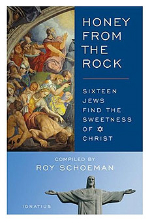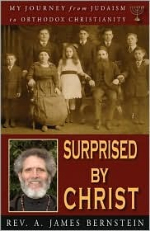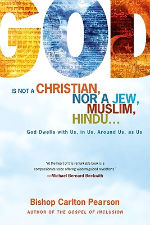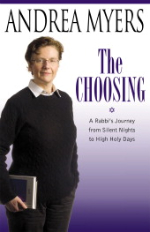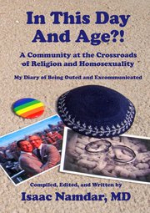Queer Rites: June 2011
Author: Thom Nickels
June 8, 2011
Many of the books that have come across my desk in the last couple of months have emphasized religious conversion, new ideas about faith, excommunication and acceptance.
The classic definition of a religious conversion is changing from one religion to another. Looking outside the LGBT spectrum for a moment, a few conversion stories (from my own library) come to mind.
Honey from the Rock
by Roy Schoeman
Ignatius
Paperback, 978158617115, 300pp.
April 2007
There’s the story of Roy Schoeman, a heterosexual Jewish convert to Catholicism who calls himself a Hebrew Catholic. In Schoeman’s book Honey from the Rock (Ignatius), the author tells the story of sixteen famous Jews in history who converted to Catholicism, including the Chief Rabbi of Rome, Rabbi Israel Zolli, who after his conversion insisted he was not giving up the synagogue for the Church. “Christianity is the integration, completion or crown of the Synagogue,” Rabbi Zolli insisted.
When it comes to changing religions, the kaleidoscope spins every which way. There are Catholics who convert to Protestantism, Islam or Judaism. There’s prolific gay author, Johnny Townsend, a birth Mormon who converted to Judaism (The Golem of Rabbi Loew, published by BookLocker.com, being his first venture into the world of Jewish storytelling).
Surprised by Christ
by Rev. A. James Bernstein
Conciliar Press
Paperback, 978188821952, 337pp.
May 2008
In the Rev. A. James Bernstein’s book—again, from my library—Surprised by Christ (Conciliar), Bernstein tells the story of how he converted to Eastern Orthodoxy from Judaism. The son of Orthodox Jews, Bernstein went on to become an Orthodox priest, but unlike Schoeman, Bernstein thinks that Orthodoxy, not Catholicism, better represents the continuation of “the synagogue.”
Switch-hitting like this is enough to make David Bowie’s The Man Who Fell to Earth thoroughly confused, were he to hunt for the one religious truth that is really true. Bowie’s alien instead would find a world of multiple belief systems and ideologies, all of them convincing in their own way.
If you want proof of this, just Google “conversion stories” and you might come up with the 1999 conversion of a noted Russian Orthodox archpriest, Viacheslav Polosin, to Islam, or the recent conversion of noted Eastern Catholic hieromonk and theologian, Fr. Gabriel Bunge, to Russian Orthodoxy. Bunge’s conversion left his readers and editors at (the Catholic) Ignatius Press scratching their heads.
In addition to widespread conversions, reversions and even a mass exodus from organized religion, the world of Christian theology is far different than it was forty years ago.
The current theological trend tends to consider all religions equal while allowing for differences in worship style and doctrine. Think of this theology as a kind of “European Union” of beliefs and you get the idea.
God is not a Christian, nor a Jew, Muslim, Hindu
by Bishop Carlton Pearson
Atria
Hardcover, 9781416584438, 304pp.
March 2010
This new theological impetus can be found in Bishop Carlton Pearson’s book, God is not a Christian, nor a Jew, Muslim, Hindu, published by Atria Books, a division of Simon and Schuster.
Bishop Pearson, who describes himself as an independent spiritual leader, asks: “What is God? Where is God? Who is the one true God?”
“It is interesting that Jesus’ favorite title for Himself was ‘Son of man,’ not ‘Son of God,’” he continues. “Jesus never attempted to make Himself a god or idol to be worshipped. He seems to have tried to draw people to the divinity within themselves.”
Reading Bishop Pearson is a lot like reading a toned down version of Episcopal Bishop John Spong. Spong, of course, came into prominence in the early 1980s when his life and scripture affirming views of homosexuality were considered daring, cutting edge, and very unorthodox. In many ways Bishop Spong in the 1980s became the Hans Kung of Anglicanism in his radical “redefinition” or interpretation of complex theological issues. (In those days a gay religious friend of mine confided that Spong’s books had almost made him lose his faith.)
Bishop Pearson’s book, which Publisher’s Weekly calls “a stirring and surprising work,” incorporates a lot of New Age and non-Christian components—he quotes Gandhi, Issac Asimov, Marianne Williamson and Flip Wilson—which can be good or bad depending on your point of view.
The gay-friendly but heterosexually married bishop with two children, tells his readers: “…I, too, am more comfortable with marriage remaining a covenant between a man and a woman, but to ‘get real,’ I’d rather see same-gender-loving people enter a monogamous commitment than live the promiscuous and non-committed life in which many people, both gay and straight, engage. How in the world could an increase in stable, loving families in this country be anything but a blessing?”
For some, hesitancy like this might merit casual condemnation, but the good bishop is just being honest. I suspect a lot more “liberal” clergy feel this way but would never say so in print.
Like Spong and Catholic-turned-Anglican priest/theologian Matthew Fox, Pearson believes that too much of Christianity today “has deteriorated into a kind of cult of myths and secret rites of initiation rather than a free and open spiritual consciousness of the Christ Principle and Person.” Christ, Pearson insists, has gotten lost in the mix of doctrinal elitism and exclusionary dogma.
The Choosing
by Rabbi Andrea Myers
Rutgers University Press
Hardcover, 9780813549576, 208pp.
April 2011
In her book The Choosing (Rutgers University Press), Rabbi Andrea Myers, a convert from Lutheranism, tells the story of her path to Judaism and her coming out as a lesbian. If you buy this book, be prepared to be entertained. Myers’ charming, anecdotal style won me over from Chapter One. Not only is she a gifted humorist, but you’ll end up admiring this woman’s courage and zest for life.
As a young college student in Boston (it doesn’t get better than Boston for a college student), Myers already sees herself as Jewish. “Over the years, I have had people tell me that Brandeis made me Jewish and gay. In retrospect, my odds at Barnard would have been the same.” After graduation, she heads to Israel because she wants “to see Judaism firsthand.” She settles in Jerusalem and, in true humorist style, cultivates her passion for falafel.
“The falafel shops hid their condiments when they saw me coming. Food also gave me the opportunity to practice my Hebrew,” she writes. At a local kosher market a rooster, issuing “a terrible shrieking squawk,” runs from an Orthodox slaughter straight into her loving arms. Myers takes the bird and heads for a bus as passengers gawk and two men chase her with knives. Ah, Jerusalem!
“It occurred to me, as I caught my breath, that I had committed some kind of crime. The prospect of being prosecuted for Grand Theft Poultry worried me less than the question of what to do with this chicken,” she writes.
Religious conversions are rarely easy, even for Myers. When she attends an Interfaith Conference in Bendorf, Germany, she’s met at the door “by a burly, red-headed woman from the Ukraine, who informed me in a voice straight out of Rocky IV that I was not to assume any leadership, and that the prayers would be strictly run according to European tradition.”
But Myers sticks it out.
She’s lucky in a sense, because her Lutheran-Catholic family, though generally conservative, comes to embrace her Judaism as well as her partner, Lisa.
“The culture of the family was to integrate whatever came, and silence was a sign of respect. Any conversation about differences was seen as an insult, and any question perceived as a criticism,” Myers writes.
The Choosing deals with Myers’ conversion story in a light hearted way and avoids heavy dives into theological reasons for the switch. I am of the school that prefers heavy reasoning. Conversions, after all, are anything but superficial unless one switches religions to marry or please a lover, so what Myers does not say about her reasons for converting is significant. In the end, I decided that the author is just too good a soul to throw what she might perceive as “dirt” at her former religion, as well as her parents, who remain Christian. She does, however, take a few comedic swipes at certain aspects of Christianity (they have to do with the mystery of the Eucharist), but they are hardly mean spirited, since Myers herself seems to be a shining example of Proverbs 15:15 (as she quotes in her book): “He who is glad of heart, feasts constantly.”
In This Day and Age?!: A Community at the Crossroads of Religion and Homosexuality
by Dr. Isaac Namdar
CreateSpace
Paperback, 9781453749210, 422pp.
October 2010
Conversion in another sense is the theme of Isaac Namdar, MD’s book, In This Day and Age?!: A Community at the Crossroads of Religion and Homosexuality. Dr. Namdar, a New York City resident, hails from a community of Sephardic religious Jews who tend to be conservative because of their Middle Eastern roots.
Dr. Namdar’s story is disturbing because in many social/cultural traditions, most notably in the United States since the 1960s, Jews are generally regarded as being in the forefront of most civil rights issues. They are also generally regarded as being more accepting than “the average Joe” when it comes to issues that divide and lead many down highways of bigotry.
In Dr. Namdar’s story we have the rare and unfortunate true story of conservative Jews thinking along “excommunication” lines, a concept that non-Jews and Christians rarely if ever equate with Judaism. The concept of Jews excommunicating fellow Jews for doctrinal transgressions or “unorthodox” beliefs or behavior might seem like bad science fiction, but this exactly what happens to the author when he’s outed by one of his own Sephardic community members when photos of Dr. Namdar’s wedding to his long-time partner are “discovered” on the Web.
This is not pornography, mind you, but wholesome marriage photos of two men in love celebrating their union.
After the outing, Namdar creates an online discussion board to open up a dialog. While he experiences a lot of support, there are also a lot of self righteous tirades, insults, and even uglier “digs.”
The story is told in a long series of (often painful) emails and phone call transcriptions. Through it all, Namdar manages to stay civil, even when he receives messages that urge him to “leave” the community if he doesn’t like the rules.
“Every office has a boss, every store has its hours, every restaurant has its own menus, you cannot change the way this community operates or demands its community members to act, you can surely disagree but your only choice is to LEAVE and don’t be a part of it,” one person tells him.
“It is so sad,” Kartaqi Guy adds, coming to Namdar’s defense and focusing on the rabbi responsible for the “excommunication.” “Rabbi Levy is such a nice person when you talk to him in person. Maybe it is our dictator-like leaders on the Central Board who are forcing him to do this. And out of fear of losing his very high-paying lucrative job, he has to do what they say. But this is no excuse. Ultimately, he cannot talk bad about another Jew, who is so harmless.”
What Namdar discovers while sorting through the hundreds of emails is the painful fact that most of us already know: Too many heterosexuals reduce homosexuals to sexual practices they find disgusting. “As seen in multiple references in the Discussion Board, many people allow themselves to discuss the sexual practices of homosexuals in graphic detail openly and publicly in an attempt to delegitimize us. They specifically and intentionally try to evoke disgust in the minds of others in order to make their point.”
In this day and age, unfortunately yes…
Note: Prolific gay author, Johnny Townsend, a birth Mormon who converted to Judaism, has just published his first Jewish storytelling book, The Golem of Rabbi Loew (BookLocker.com, Inc.). Townsend’s books have traditionally concentrated on Mormon stories and issues.

